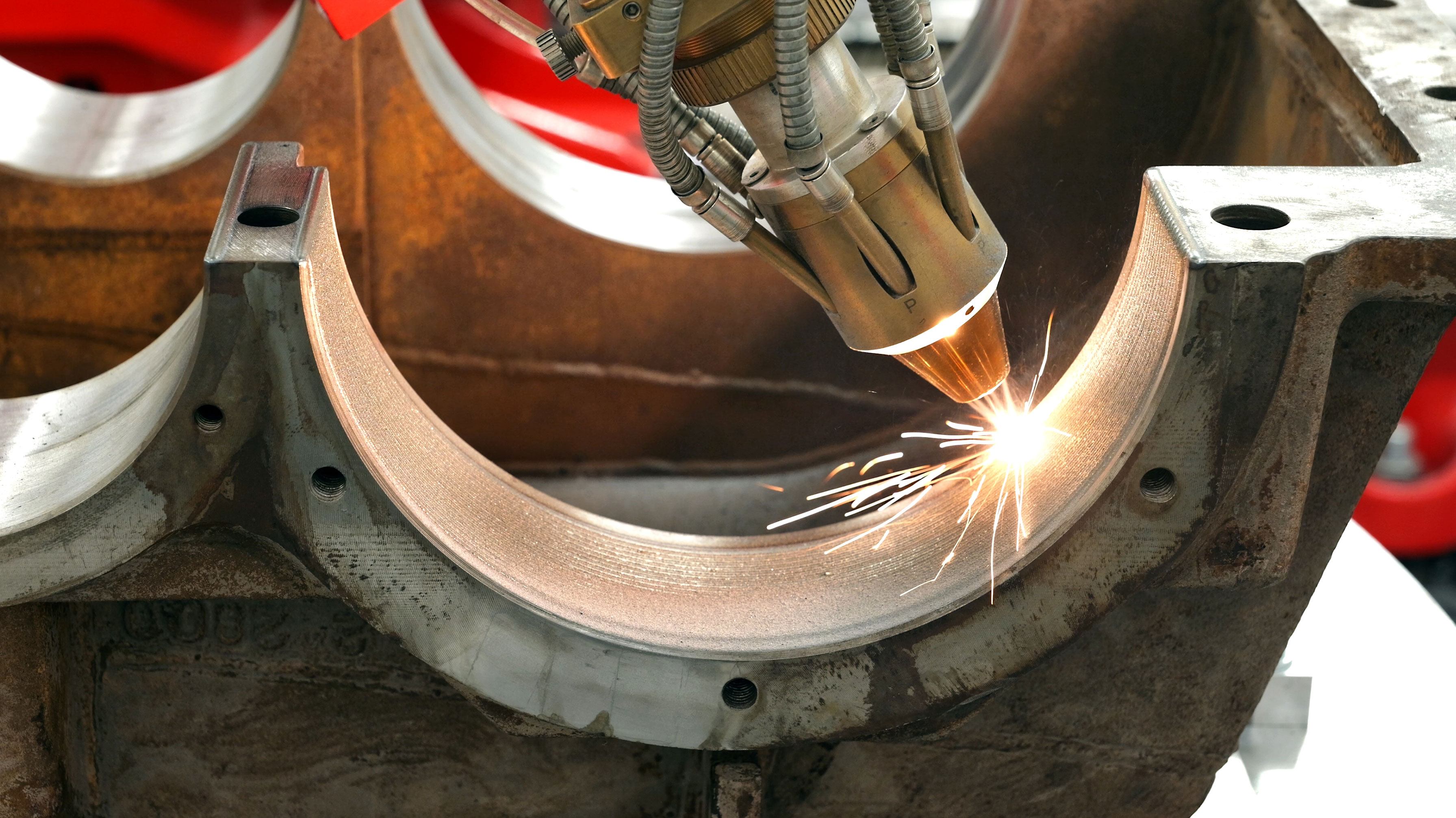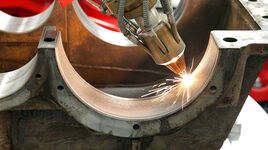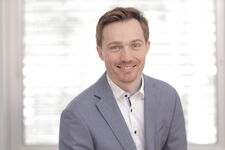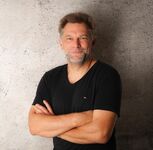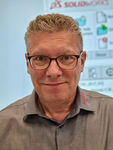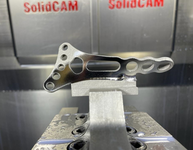Additive manufacturing scores well in repairs and sustainability
How do future technologies find their way into factories? Although the integration of additive manufacturing (AM) holds out the promise of competitive advantages, many companies appear to be hesitant and less familiar with the processes. This is especially true of small and medium-sized enterprises in the mechanical engineering industry. However, their wide range of applications would be important so that AM can develop from the niche segment of prototype and small-series production into industrial production. It is helpful to have solutions which can be implemented quickly and with acceptable costs. However, there is still the challenge involved in developing necessary know-how and an understanding of the process chain, and having adequately trained personnel available.
The German Machine Tool Builders' Association (VDW), Frankfurt am Main, accords additive manufacturing processes strong growth potential and further application areas which can mainly be found at present in aerospace engineering, medical technology and automobile construction. 3D printers for the additive manufacturing of goods from metal belong to the nomenclature of machine tools and can be found in the VDW trade fairs. Since very recently, these trade fairs also include NORTEC (23 to 26 January 2024) in Hamburg, which VDW and Messe Stuttgart are jointly staging for the first time. At the Trade Fair for Manufacturers, suppliers and contract manufacturers will present their services along with specialists for upstream and downstream stages along the value-added chain.
Repair technologies conserve resources
"Small and medium-sized enterprises primarily demand additive manufacturing for repairs and maintenance," said Dr. Clemens Kuhn, CEO of ALOtec Dresden GmbH, one of the exhibitors at NORTEC. The company, a spin-off from the Fraunhofer Institute for Material and Beam Technology (IWS), specialises in the processes of laser hardening and laser deposition welding with powder and wire. As Kuhn explained, these are technologies which, when compared with conventional hardening processes and welding technologies, produce advantages primarily due to the defined energy input applied to the component by a laser. Kuhn said that the topic of sustainability plays an important role for users wanting to contact ALOtec: "Thanks to our laser systems and technologies, we can repair and refurbish components instead of disposing of them and producing new components." He mentioned, as an example, welding of a tooth on a gearwheel component in need of repair. "Repairs are also advantageous in terms of material shortage and delivery times." During NORTEC the company will also demonstrate its know-how relating to the mobile use of laser robots for hardening and deposit welding as an important aspect in order to appeal to and impress companies from the areas of shipbuilding or mechanical engineering, as well as offshore producers.
Momentum in times of climate production and decarbonisation
The growing importance of resource conservation and energy efficiency in the demand for AM processes was confirmed by Prof. Ingomar Kelbassa, Director of the Fraunhofer Research Institution for Additive Manufacturing Technologies (IAPT) in Hamburg: "In the recent past there was a substantial increase in the number of inquiries relating to sustainability and decarbonisation, especially from small and medium-sized enterprises," said Kelbassa. "If AM production routes prove to be not only more productive, but also help to conserve resources and reduce the CO2 footprint, acceptance in industry will increase significantly," said the scientist. "However, acceptance also largely depends on the availability of skilled workers in the non-academic sector, i.e. engineers.
AM is a craft trade that needs to be automated," emphasised Institute Director Kelbassa. "Here at the Fraunhofer IAPT we are therefore working closely with the Hamburg Chamber of Crafts and its Elbcampus in order to be able to offer an advanced training course as a '3D printing specialist' from the middle of 2024 onwards. The industrialisation of AM is a strategic objective in Hamburg: "Our flagship initiative IAMHH – Industrialized Additive Manufacturing Hub Hamburg – focuses on both technical topics and training topics in the academic and non-academic sectors." Around 70 companies and nearly every well-known R&D partner from the region are on board in order to speed up the industrialisation of AM.
Science and industry actively involved in training and qualification
Training and qualification of skilled workers are a perennial issue, and not just since the German Academic Association for Production Technology (WGP) sounded the alarm due to decreasing student numbers. This group of leading professors founded the WGP Production Academy in 2015. The WGP Production Academy stages advanced training events on future technologies, including the series entitled "Mechatronic functionalisation through 3D printing processes".
In 2009 VDW founded the Mechanical Engineering Youth Foundation which regards itself as a partner for vocational training. The Foundation, which will also be present at NORTEC, concentrates on innovative technologies such as additive manufacturing and new materials, but also new forms of work organisation.
However, companies have to show own initiative on account of "serious deficits in training and further training", a complaint that has also been raised by Jörg Vollmann-Schipper, Sales Manager at the company SolidCAM Additive in Schramberg. "Although training institutes are extremely interested in future technologies such as AM, there is hardly any latitude to actually include it in the curriculum." Although a solution through attendance at events is therefore being sought, this is proving to be "long and difficult".
Implementation made easy
SolidCAM, one of the leading suppliers of CAD/CAM solutions and also an exhibitor at NORTEC, wants to make access to additive manufacturing easier, especially for mechanical engineering companies, and primarily help small and medium-sized enterprises to print complex metal parts at high speed and with great reproducibility. CEO Emil Somekh therefore decided to cooperate with the American company Desktop Metal, a manufacturer of 3D printing systems, and founded SolidCAM Additive GmbH. "The key factor was the realisation that the introduction of additive manufacturing involves much more than merely installing a 3D metal printer," said Somekh.
The experience from decades of cooperation with machine tool manufacturers will help to overcome scepticism, especially among small companies. "We are currently sensing a certain amount of reluctance among small and medium-sized enterprises", confirmed Sales Manager Jörg Vollmann-Schipper. In order to convince customers about the advantages of AM, datasets for benchmarks are initially requested. The company making the inquiry receives a printed component along with a cost estimate. "We maintain close contact with the customer during this phase so that we can design the printed component on his machine fleet, if required, for processing at a later date."
Objective: impart an understanding of the entire process
In order to help mechanical engineering companies, two competence centres that integrate 3D printing and CNC processing were set up at SolidCAM. It is said that 3D printing will also still need post-processing through CNC processing. This ensures that parts comply with the required specifications. The software experts from the Black Forest are aiming here for continuous processing of data from the CAD programme and 3D printing through to programming of the processing machine by means of SolidCAM software. Using an example from medical technology, Vollmann-Schipper clearly shows what this looks like: 1 millimetre of material was printed on both sides of a printed bone plate. A clamping range was also added in order to have a defined position in the machining centre. This means that no special fixture is needed to machine the components. Time and money are saved during final machining.
In an integrated production route the Fraunhofer IAPT regards post-processing and finishing as the true time and cost drivers. "If AM is regarded as an end-to-end production route," said Ingomar Kelbassa, "it is shown that only around 5 to 20 per cent of production time and the resulting costs can be assigned directly to the 3D printing process." Much more time and very high costs were expended, for example, for depowdering, removing components from the construction platform, removing the supporting structures, heat treatment, milling and other process steps relating to surface finishing. "The continuing industrialisation of AM is therefore by no means just a question of developing the 3D printing process," said Kelbassa, "but more a question of integrated optimisation of the complete production route." According to Kelbassa, the main ingredients here include topics such as complete virtualisation, automation, machine transferability, line integration and coupling to MES and ERP systems. Substantial advances were made recently, especially in industry-related topics. If acceptance among small and medium-sized companies can then be successfully increased, the confidence of Kelbassa is understandable. He emphasised the following: "Industrialisation of AM is picking up speed!"
Author: Cornelia Gewiehs, specialised journalist, Rotenburg (Wümme)
Photos:
01 ALOpowderProzess
ALOtec supplies solutions to repair even hard-to-access areas or generate new structures for additive manufacturing.
Photo: ALOtec GmbH
02 Kuhn ALOtec
Dr. Clemens Kuhn, CEO of ALOtec Dresden GmbH. The company supplies laser systems and technologies in order to repair and refurbish components instead of having to dispose of them and produce new components.
Photo: ALOtec GmbH
03 Kelbassa Fraunhofer IAPT
Prof. Ingomar Kelbassa, Director of the Fraunhofer IAPT, sees a mission in the supply chain problems: "The objective must be resilience of the entire AM production route, from raw material production to the end of the product lifecycle. We must ultimately be able to operate production routes independently of third countries."
Photo: Private
04 Vollmann Schipper SolidCAM Additive
Jörg Vollmann-Schipper, Sales Manager at SolidCAM Additive, sees a certain amount of reluctance among small and medium-sized enterprises in regard to additive manufacturing. Close contact and support are all the more important in order to enable even small companies to print complex metal parts at high speed and with great reproducibility.
Photo: SolidCAM Additive
05 SolidCAM Additive Knochenplatte
A bone plate as an example from medical technology: the software experts from SolidCAM Additive are aiming for continuous processing of data from the CAD program and 3D printing through to programming of the processing machine.
Photo: SolidCAM Additive
Contacts
VDW
Gerda Kneifel
Press and Public Relations
Lyoner Strasse 18
60528 Frankfurt am Main
Germany
Tel. +49 (0)69 756081-32
ALOtec Dresden GmbH
Christoph Taupadel
Marketing
Zum Wiesengrund 2
01723 Kesselsdorf
Germany
Christoph.Taupadel(at)alotec.de
Tel. +49 (0)35204 794412
Fraunhofer Research Institution for Additive Manufacturing Technologies (IAPT)
Carola Dellmann
Marketing & Communication
Am Schleusengraben 14
21029 Hamburg
Germany
carola.dellmann(at)iapt.fraunhofer.de
Tel. +49 (0)40 484010-843
SolidCAM Additive GmbH
Jörg Vollmann-Schipper
Sales Manager
Gewerbepark H.A.U. 36
78713 Schramberg
Germany
Tel. +49 (0)7422 2494-14
Cornelia Gewiehs
Specialised journalist
Grosse Strasse 35
27356 Rotenburg (Wümme)
Germany
Tel. +49 (0)4261 1663
Background
NORTEC 2024 – Trade Fair for Manufacturers
NORTEC will be held in Hamburg from 23 to 26 January 2024. As the Trade Fair for Manufacturers, NORTEC provides a platform for industry in north Germany, the neighbouring Scandinavian markets, the Netherlands and Belgium. The key exhibition areas are machine tools and production systems, precision tools, robotics and automation, software, digital and IT solutions, control and regulation technology, measurement and testing technology, quality assurance, electronics production, components and assemblies, materials, order and contract manufacturing, services, conveyor and storage technology, logistics management, operating equipment and accessories. The target groups are buyers from industry (mechanical engineering and plant construction, metal working and processing industry, motor vehicle construction, aerospace engineering, medical technology, tool construction and mould making, electrical engineering and electronics industry, maritime technology / shipbuilding, precision mechanics / optics, contractors, components suppliers), the service sector, craft trades and the retail trade. The trade fair is staged jointly by Messe Stuttgart and VDW every two years.
back to overview